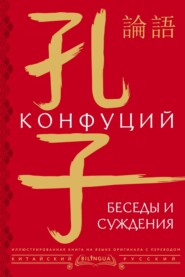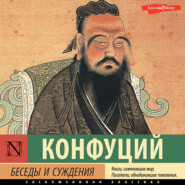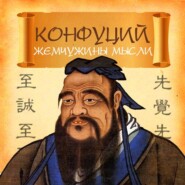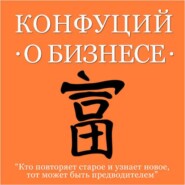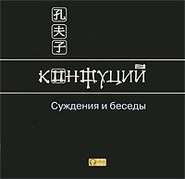По всем вопросам обращайтесь на: info@litportal.ru
(©) 2003-2024.
✖
Chinese Literature
Автор
Год написания книги
2018
Настройки чтения
Размер шрифта
Высота строк
Поля
From Confucius, it is generally thought.
30
Confucius had now retired from office, and this incident occurred only two years before his death.
31
It is a habit with the Chinese, when a number are out walking together, for the eldest to go first, the others pairing off according to their age. It is a custom much older than the time of Confucius.
32
Different woods were adopted for this purpose at the various seasons.
33
He only pretended to be mad, in order to escape being employed in the public service.
34
Two worthies who had abandoned public life, owing to the state of the times.
35
The title of this book in Chinese is—"King Hwuy of Lëang; in chapters and sentences." Like the Books of the Confucian Analects, those of this work are headed by two or three words at or near the commencement of them. Each Book is divided into two parts. This arrangement was made by Chaou K'e, and to him are due also the divisions into chapters, and sentences, or paragraphs, containing, it may be, many sentences.
36
Sëang was the son of King Hwuy. The first year of his reign is supposed to be B.C. 317. Sëang's name was Hih. As a posthumous epithet, Sëang has various meanings"Land-enlarger and Virtuous"; "Successful in Arms." The interview here recorded seems to have taken place immediately after Hih's accession, and Mencius, it is said, was so disappointed by it that he soon after left the country.
37
Ch'ang-gan is still the name of the principal district (and its city) in the department of Se-gan, Shen-se. It had been the capital of the first empire of Han (B.C. 202 A.D. 24), as it subsequently was that of Suy (A.D. 589-618).
38
The period Hwang-che embraced from A.D. 399 to 414, being the greater portion of the reign of Yâo Hing of the After Ts'in, a powerful prince. He adopted Hwang-che for the style of his reign in 399, and the cyclical name of that year was Kang-tsze. It is not possible at this distance of time to explain, if it could be explained, how Fâ-hien came to say that Ke-hâe was the second year of the period. It seems most reasonable to suppose that he set out on his pilgrimage in A.D. 399, the cycle name of which was Ke-hâe. In the "Memoirs of Eminent Monks" it is said that our author started in the third year of the period Lung-gan of the Eastern Ts'in, which was A.D. 399.
39
Lung embraced the western part of Shen-se and the eastern part of Kan-suh. The name remains in Lung Chow, in the extreme west of Shen-se.
40
K'een-kwei was the second king of "the Western Ts'in." Fâ-hien would find him at his capital, somewhere in the present department of Lan-chow, Kan-suh.
41
Chang-yih is still the name of a district in Kan-chow department, Kan-suh. It is a long way north and west from Lan-chow, and not far from the Great Wall. Its king at this time was, probably, Twan-yeh of "the northern Lëang."
42
Dâna is the name for religious charity, the first of the six pâramitâs, or means of attaining to nirvâna; and a dânapati is "one who practises dâna and thereby crosses the sea of misery."
43
This was the second summer since the pilgrims left
Ch'ang-gan. We are now, therefore, probably, in A.D. 400.
44
T'un-hwang is still the name of one of the two districts constituting the department of Gan-se, the most western of the prefectures of Kan-suh; beyond the termination of the Great Wall.
45
This is the name which Fâ-hien always uses when he would speak of China, his native country, as a whole, calling it from the great dynasty which had ruled it, first and last, for between four and five centuries. Occasionally, as we shall immediately see, he speaks of "the territory of Ts'in or Ch'in," but intending thereby only the kingdom of Ts'in, having its capital in Ch'ang-gan.
46
Meaning the "small vehicle, or conveyance." There are in Buddhism the triyâna, or "three different means of salvation, i.e. of conveyance across the samsâra, or sea of transmigration, to the shores of nirvâna. Afterwards the term was used to designate the different phases of development through which the Buddhist dogma passed, known as the mahâyâna, hînayâna, and madhyamayâna." "The hînayâna is the simplest vehicle of salvation, corresponding to the first of the three degrees of saintship." E.H., pp. 151-2, 45, and 117.
47
"Sraman" may in English take the place of Sramana, the name for Buddhist monks, as those who have separated themselves from (left) their families, and quieted their hearts from all intrusion of desire and lust.
48
Mahâyâna is a later form of the Buddhist doctrine, the second phase of its development corresponding to the state of a Bodhisattva, who, being able to transport himself and all mankind to nirvâna, may be compared to a huge vehicle.
49
A worshipping place, an altar, or temple.
50
The Sapta-ratna, gold, silver, lapis lazuli, rock crystal, rubies, diamonds or emeralds, and agate.
51
A Bodhisattva is one whose essence has become intelligence; a Being who will in some future birth as a man (not necessarily or usually the next) attain to Buddhahood. The name does not include those Buddhas who have not yet attained to parinirvâna. The symbol of the state is an elephant fording a river.
52
This was the retreat already twice mentioned as kept by the pilgrims in the summer, the different phraseology, "quiet rest," without any mention of the season, indicating their approach to India. Two, if not three, years had elapsed since they left Ch'ang-gan. Are we now with them in 402?
53
Watters calls attention to this as showing that the monks of K'eeh-ch'â had the credit of possessing weather-controlling powers.







